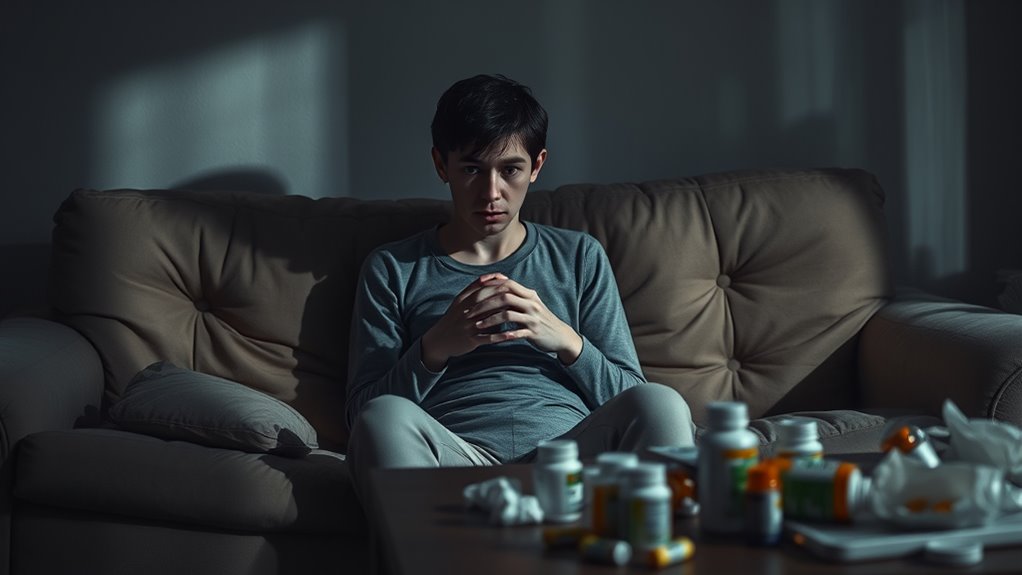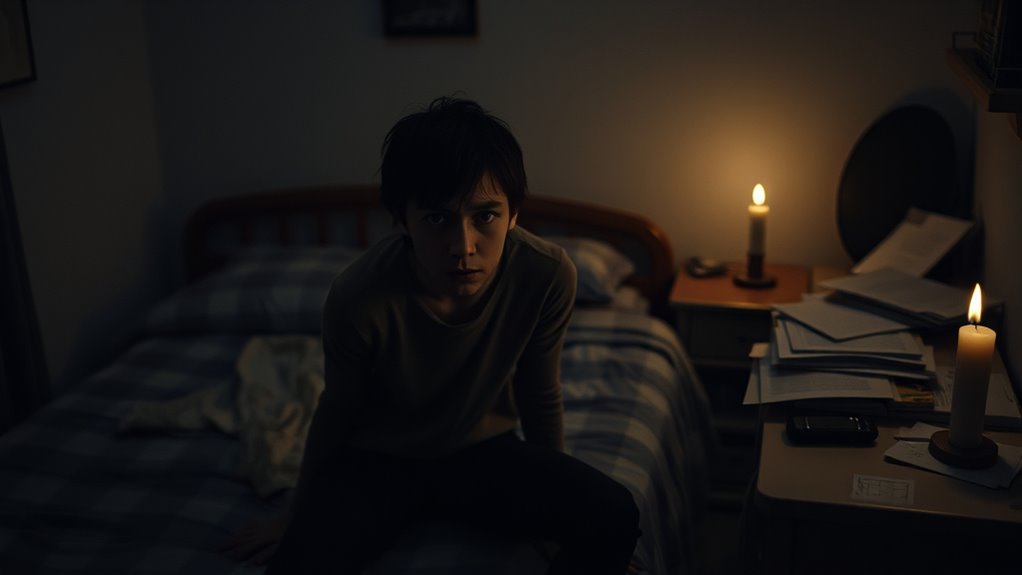If you’re exploring BPD and anxiety disorders, it’s important to know they often occur together, intensifying emotional instability and impulsivity. Many with BPD experience symptoms like panic attacks, worries about abandonment, and physical sensations that worsen during stress. Childhood trauma, genetics, and environmental factors play a role. Effective management includes therapy, medication, and coping skills, which can improve outcomes. To understand how these conditions interact and ways to support someone, find out more below.
Key Takeaways
- Many individuals with BPD also experience comorbid anxiety disorders, worsening emotional instability and impulsivity.
- Childhood trauma, especially emotional abuse and neglect, increases vulnerability to both BPD and anxiety disorders.
- Dysregulation of the HPA axis and immune system links trauma to the development of both conditions.
- Effective treatment combines therapies like DBT and CBT with medications such as SSRIs to manage symptoms.
- Support strategies include education, mindfulness, coping skills, and a stable environment to improve emotional regulation.
Understanding the Link Between BPD and Anxiety Disorders

Understanding the link between Borderline Personality Disorder (BPD) and anxiety disorders reveals a complex and often intertwined relationship. Many individuals with BPD also experience comorbid anxiety disorders like social phobia, panic disorder, PTSD, or GAD, which can intensify symptom severity, including impulsivity and emotional instability.
BPD often coexists with anxiety disorders, worsening emotional and impulsive symptoms.
Childhood maltreatment, especially emotional abuse and neglect, plays a significant role in this connection, increasing vulnerability to both BPD and anxiety symptoms. Adverse childhood experiences have been shown to influence neurobiological development, further linking early trauma with these conditions. Additionally, the dysregulation of the HPA axis is believed to contribute significantly to these overlapping disorders, impacting stress response mechanisms.
Neurobiological factors, such as dysregulation of the HPA axis and immune system alterations, contribute to their coexistence.
Research also indicates that emotional dysregulation and emotional instability are core features shared by both BPD and anxiety disorders, further blurring the lines between these conditions.
This comorbidity often leads to worse clinical outcomes, including higher risks of hospitalization and suicide.
Trauma during childhood can set the stage for persistent anxiety and emotional dysregulation, reinforcing the complex relationship between BPD and anxiety disorders.
Common Anxiety Symptoms in Individuals With BPD

Have you noticed that many individuals with Borderline Personality Disorder (BPD) also experience intense and unpredictable anxiety symptoms? These anxiety symptoms often arise suddenly, fueling emotional instability and impulsivity.
Common signs include:
- Panic episodes with physical sensations like headaches or stomach pain
- Persistent worry and fear, especially related to abandonment
- Physical sensations that escalate during stress triggers
- Unexpected episodes lasting minutes to hours, worsening emotional dysregulation
In BPD, anxiety symptoms can fluctuate based on stress levels, intensifying emotional dysregulation and impulsivity. Because of comorbid anxiety, these symptoms are often intertwined with emotional instability, making it harder to manage daily life. Recognizing the role of emotional dysregulation is crucial in understanding how anxiety manifests and impacts individuals with BPD. Additionally, stress management strategies can help mitigate some of these symptoms and improve overall stability.
Furthermore, genetic variation can contribute to the presence of symptoms like a black coat in some breeds, which may parallel the variability seen in anxiety presentations among individuals with BPD. Recognizing cultural differences in how anxiety is experienced can also help tailor effective treatment approaches. A better understanding of the underlying psychological factors can improve management strategies for anxiety symptoms in BPD.
Factors Contributing to Anxiety in BPD Patients

Childhood maltreatment, such as emotional abuse and neglect, plays a significant role in increasing the likelihood of developing anxiety disorders in individuals with BPD. Early adverse experiences can lead to neurobiological alterations that heighten stress sensitivity and emotional dysregulation. Additionally, vetted portable camping gear options for various outdoor settings highlight the importance of reliable equipment in ensuring safety and comfort in unpredictable environments. These changes make you more reactive to stress and prone to impulsivity, which often contribute to comorbid anxiety disorders like social phobia or GAD. A genetic predisposition and a family history of anxiety further increase your risk. These factors can worsen clinical outcomes, intensifying BPD symptoms and complicating treatment. Understanding how childhood maltreatment and neurobiological changes influence anxiety helps explain the complex interplay between early experiences and the severity of BPD, highlighting the importance of addressing these contributors in clinical management. Additionally, emotional regulation techniques are important for managing heightened stress responses in affected individuals. Moreover, air pollution and pollutants from wood-burning can exacerbate stress levels and overall mental health, further complicating anxiety management in vulnerable populations. Recent research also suggests that neuroplasticity may offer potential avenues for therapeutic intervention by modifying maladaptive neural pathways.
Strategies for Managing Anxiety Symptoms in BPD

Managing anxiety symptoms in individuals with BPD requires a multifaceted approach that combines therapy, medication, and skill development. To help you better manage anxiety, consider these strategies:
Managing anxiety in BPD involves therapy, skills, and addressing underlying issues for lasting relief.
- Practice Dialectical Behavior Therapy (DBT) to improve emotional regulation and reduce anxiety episodes triggered by interpersonal stress. DBT also emphasizes validation and mindfulness, which are crucial for emotional stability. Incorporating emotional regulation techniques can further enhance your ability to manage intense feelings and reduce anxiety. Engaging in regular mindfulness practices can strengthen your capacity to stay present and observe your thoughts without judgment.
- Incorporate mindfulness techniques to increase self-awareness and tolerate distress more effectively. Regular mindfulness practice can help you recognize early signs of anxiety and respond more adaptively.
- Develop coping skills to handle emotional dysregulation and recognize anxiety triggers early. Building a coping toolkit with personalized strategies can empower you to manage overwhelming feelings more confidently.
- Address underlying trauma and comorbidities through targeted treatment strategies for long-term relief. Understanding the connection between trauma and emotional responses can facilitate more effective intervention.
- Explore protective styling options, such as crochet styles for locs, to promote physical and emotional well-being by maintaining hair health and reducing stress-related concerns. Engaging in self-care routines like these can improve your overall sense of control and comfort.
Using these methods, you can enhance self-management, lessen anxiety’s impact, and improve overall well-being despite challenges related to BPD, emotional dysregulation, and comorbidities.
Treatment Approaches for Co-occurring BPD and Anxiety Disorders

Effective treatment for individuals with co-occurring BPD and anxiety disorders often involves integrating evidence-based psychotherapies with appropriate medication management. Dialectical Behavior Therapy (DBT) and Cognitive Behavioral Therapy (CBT) target emotional regulation and reduce symptoms of comorbid anxiety. Pharmacological management, typically with SSRIs like sertraline or fluoxetine, helps alleviate anxiety symptoms while being carefully monitored for side effects. Combining psychotherapy with medication improves clinical outcomes, decreasing impulsivity and hopelessness. Tailoring treatment plans to specific anxiety symptoms, such as social phobia or GAD, enhances overall functioning. Early intervention and integrated treatment approaches address the complex interplay between emotional dysregulation and anxiety, leading to better long-term prognosis.
| Treatment Focus | Key Strategies |
|---|---|
| Psychotherapy | DBT, CBT, emotional regulation |
| Pharmacological Management | SSRIs, monitoring for side effects |
| Overall Approach | Integrated treatment, early intervention |
Supporting Loved Ones Living With BPD and Anxiety

To effectively support your loved one, start by learning about BPD traits and how they affect behavior. Pay attention to their anxiety triggers and help them develop strategies to manage emotional ups and downs. Additionally, understanding mindfulness practices can provide comforting entertainment and a sense of normalcy during difficult times. Your understanding and patience can create a stable environment that encourages their ongoing healing process. Recognizing the horsepower of electric dirt bikes can also be a helpful analogy when discussing their energy levels and emotional intensity, fostering better communication. Being aware of home security systems can also provide peace of mind, knowing that their environment is safe and protected during vulnerable moments. Incorporating predictive analytics concepts may assist in identifying patterns in their behavior, allowing for more proactive support.
Educate About BPD Traits
Understanding the traits of Borderline Personality Disorder (BPD) can help you better support loved ones who also struggle with anxiety. Recognizing key borderline personality traits, like emotional instability, impulsivity, and emotional dysregulation, is essential.
These traits often include intense mood swings, a fear of abandonment, and heightened emotional reactions that can overwhelm. Anxiety symptoms amplify interpersonal stress and feelings of emptiness, making everyday interactions more challenging.
To support your loved one effectively, focus on these aspects:
- Notice mood swings and emotional dysregulation
- Understand impulsivity and its triggers
- Recognize fear of abandonment and interpersonal stress
- Be patient with heightened emotional reactions
- Be aware of AI vulnerabilities, which can influence emotional responses and trust issues.
Educating yourself about these traits fosters empathy and helps you provide meaningful support.
Recognize Anxiety Triggers
Recognizing what triggers anxiety in your loved one with BPD can make a significant difference in providing support. In borderline personality disorder, anxiety triggers often stem from perceived abandonment, rejection, or criticism, leading to intense emotional responses.
External stressors, like interpersonal conflicts or crowded settings, can also provoke anxiety symptoms. Internal triggers, such as sudden mood shifts, feelings of emptiness, or intrusive thoughts, may escalate anxiety further.
By recognizing early signs—like irritability, hypervigilance, or increased agitation—you can intervene before anxiety becomes overwhelming.
Understanding that these reactions are often reactive to interpersonal stressors enables you to offer reassurance and support and facilitate timely intervention, helping your loved one manage their emotional responses more effectively.
Support Emotional Stability
Supporting your loved one with BPD and anxiety involves consistent, compassionate efforts to foster emotional stability. Your role is crucial in helping them manage anxiety disorders through understanding and patience.
Here are four ways to support their emotional regulation:
- Educate yourself about BPD and anxiety disorders to build empathy and patience.
- Offer reassurance and maintain a supportive system during emotional fluctuations.
- Encourage the use of coping strategies and grounding techniques to handle anxiety episodes.
- Promote ongoing therapy and medication management as essential components of their mental health care.
Frequently Asked Questions
Can You Have BPD and Anxiety Disorder?
Yes, you can have both conditions. When you experience intense emotional instability and impulsivity, along with persistent anxiety, it’s possible that you’re dealing with more than one mental health issue.
These can interact and make symptoms worse, affecting your daily life. It’s important to seek a thorough assessment so you get the right treatment plan that addresses everything you’re facing, helping you manage symptoms more effectively.
What Are the 3 C’s of BPD?
The 3 C’s refer to Crisis, Chronic emptiness, and Control issues. You experience intense crises often triggered by fears of abandonment or emotional instability.
You might feel a persistent emptiness that leads to impulsive acts or self-harm.
Controlling your emotions and impulses can be difficult, causing rapid mood swings.
Recognizing these patterns helps you understand your emotional and behavioral experiences better, guiding you toward healthier coping strategies.
What Happens if BPD Is Untreated?
If you leave BPD untreated, it’s like walking through a storm without an umbrella. Your emotional landscape becomes a wild, unpredictable ocean, with waves of impulsivity and instability crashing harder each day.
Without help, you risk sinking into deep despair, harming yourself, or facing mounting relationship and life struggles.
Early treatment acts like a lighthouse, guiding you safely through the chaos towards stability, hope, and a chance for a brighter future.
What Is the Trauma of Dating Someone With BPD?
When you date someone with intense emotional shifts, you might experience frequent conflicts, feelings of instability, and uncertainty about the relationship’s future.
Their impulsive actions and fear of abandonment can cause you emotional exhaustion, anxiety, and guilt.
You may feel torn between wanting to support them and protecting your own mental health, leading to a cycle of hope and disappointment that emotionally drains and traumatizes you over time.
Conclusion
Did you know that nearly 70% of people with BPD also experience an anxiety disorder? Understanding the strong link between BPD and anxiety can help you better support loved ones or seek effective treatment. By recognizing common symptoms and applying targeted strategies, you can manage these challenges together. Remember, with the right approach, recovery and stability are possible—you’re not alone in this journey.









